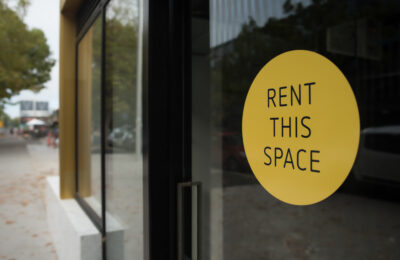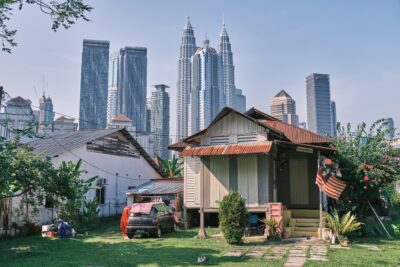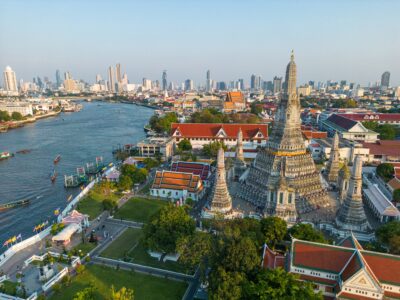The Philippines’ airports go from worst to best
The new gatekeepers of the award-winning second terminal at Mactan-Cebu airport have subverted the steel-clad norm by utilising nautical motifs, handcrafted tiles, and plentiful wood
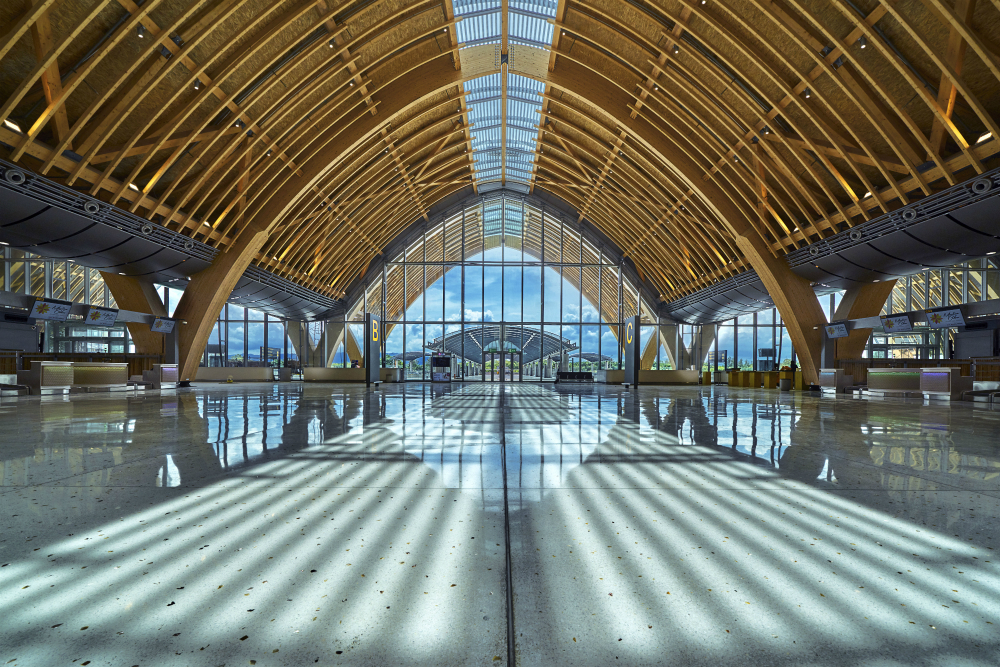
Kenneth Cobonpue has long been familiar with the flying options out of Cebu. In fact, the old Mactan-Cebu International Airport was a portal to adventure for the renowned designer well before he was creating bespoke furniture for the likes of Barack Obama, Brad Pitt and Angelina Jolie.
“I remember, as a kid, sitting on handmade hardwood benches with carvings,” Cobonpue says of the old terminal, which was formerly a US airbase before it was commandeered for public air travel back in 1966. “It was quite dark, but it was like walking into an old Filipino home.”
With his involvement in the award-winning new second terminal at the airport – the second-busiest in the Philippines after Manila – the Cebuano has come full circle.
Cobonpue, along with Hong Kong architecture firm Integrated Design Associates Ltd. (IDA) and Filipino design powerhouse BUDJI+ROYAL Architecture+Design, pooled their visions for the airport’s second terminal—the Philippines’ first airport-centric public-private partnership (PPP) agreement.

The much-anticipated PHP17.5-billion (USD340 million) project opened in July 2018 and, four months later, won the CAPA Aviation Award for Asia Pacific Airport of the Year.
The design luminaries constellated at the prodding of GMR Megawide Cebu Airport Corporation (GMCAC), which won the concession to run the airport in December 2013. The consortium, composed of Filipino general contractor Megawide Construction Corporation and Bangalore-based infrastructure developer GMR Group, bid PHP33 billion for the contract to Build, Operate and Transfer (BOT) the terminals over a 25-year period ending 2039.
“It was a very fluid process with IDA and Kenneth,” says Royal Pineda, principal architect and CEO at BUDJI+ROYAL. “We freely talk about our thoughts and our visions, and we all understand that at the end of the day, everything should reinforce the project’s main objective.”
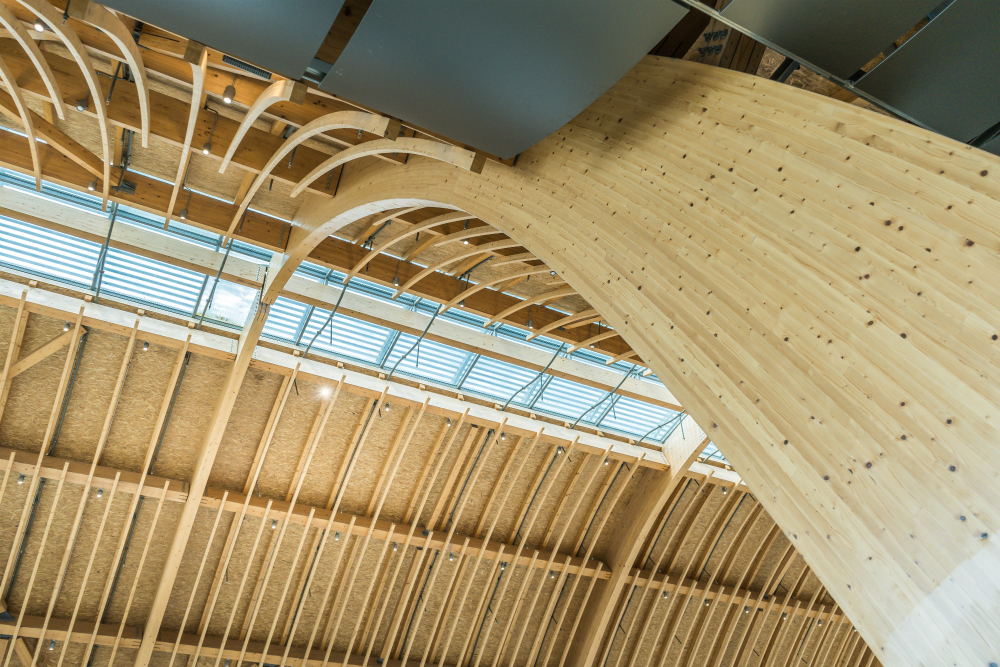
Roping in GMR was an inspired choice by Megawide. Having elevated, in only a decade, Delhi’s Indira Gandhi International Airport from one of the world’s most vilified air hubs to an Airport Service Quality (ASQ) award winner, GMR’s involvement somehow dissociates Mactan from Manila’s Ninoy Aquino International Airport (NAIA), which is also consistently rated among the world’s shoddiest airports.
It was critical to involve private sector in the project, points out Cobonpue. “The rules governing public construction – like the bidding process, for example – make it very difficult to create something really unique and monumental. Bureaucracy can really constrain us, creatively. Working with private sector opens the possibility to build something we can all be proud of.”
Most airport terminals tend to be very cold, typically using industrial materials like concrete, glass, and steel. The Mactan airport, in contrast, uses materials that give a very warm feeling: the use of wood, the handwoven counters, the handcrafted tiles with randomised patterns to mimic sand underfoot
GMCAC officially took over operations from the state-run Mactan-Cebu International Airport Authority (MCIAA) in November 2014. Construction of Terminal 2 began in June 2015. Led by its founder Winston Shu, IDA was tasked with preparing the preliminary designs of the terminal. Visualised as a silhouette of pointed roofs, in the vein of sails, the initial concept received pushback from the Filipino designers as sails were not endemic to seafarers around Mactan.
“There is no sailing around because we don’t have the winds capable of blowing sails. So, we patterned the roof after the waves of the ocean instead,” says Cobonpue.
More: Philippine airport outshines Singapore Changi at World Architecture Festival
To create the terminal’s superstructure, the consortium favoured wood over steel. Megawide imported 4,500 square metres of glue-laminated (glulam) spruce from Austrian timber company Rubner Holzbau. The “waves” on the roof are a succession of 10 glulam arches, each 30 metres wide. Reaching heights of 18 metres, the eye-catching arches call to mind the ceilings of the cathedrals that dot the Philippines, a predominantly Catholic nation.
“Most airport terminals tend to be very cold, typically using industrial materials like concrete, glass, and steel. The Mactan airport, in contrast, uses materials that give a very warm feeling: the use of wood, the handwoven counters, the handcrafted tiles with randomised patterns to mimic sand underfoot,” Cobonpue says.
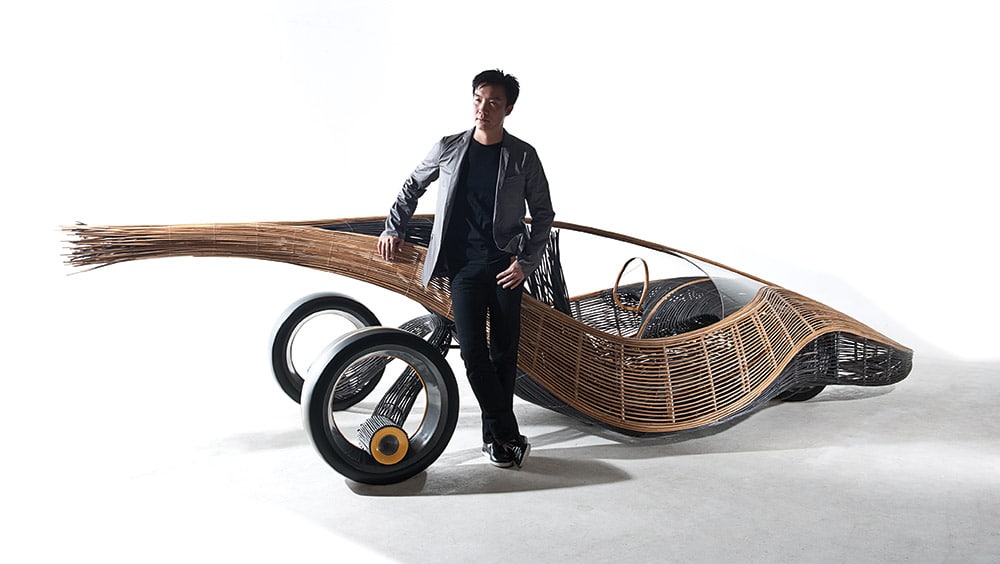
More than its architectural aesthetic and structural integrity, the use of glulam made for “a very good, progressive construction approach,” avers Pineda. Glulam was strong but pliable enough to create the terminal’s intricate complex of freestanding Y-shaped parabolic pillars, x-braced rafters, and parallel braced beams. Together they lessened the number of columns, resulting in a very open internal volume. The curvilinear glulam beams comprising the underbelly of the arches are left exposed, akin to the hull of a boat. “The roof design feels very nautical and echoes how boats in the Philippines were once made,” informs Cobonpue.
Daylight soaks the 65,000-square-metre terminal. Skylights of tempered glass run along the roof apex, while a glazed façade encloses both ends of the terminal. Crushed, iridescent mother-of-pearl shards, embedded in the terrazzo, glisten in the sunlight. “The concept of the airport is to have a tropical island resort experience. As its roof silhouette reminisces the waves of Cebu waters, its interiors exude its famous tropical beaches, simulating the walk on sand, complete with shells dotting its seashore,” says Pineda.
Such design flourishes ground the airport in a Cebuano identity separate from a generic sense of Filipino pride. “The woven counters and the mothers-of-pearl on the tiles are uniquely Cebu. You can’t find those in Manila,” says Cobonpue. His team welded extruded aluminium onto the Terminal’s 48 check-in counters—it has room for 72—to create open lattices around which they wove recyclable polyethylene. LED backlights illumine the lattices and change colours according to season, given that the Philippines is “big on holidays.”
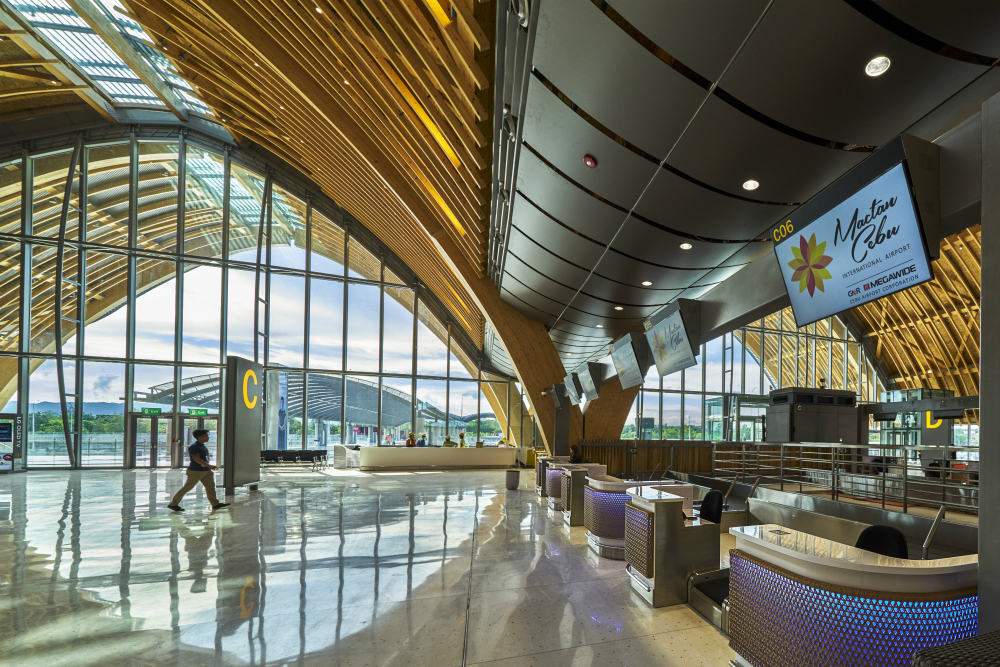
The low heights of the counters betray the terminal’s oriental leanings. “Many of the visitors, if not most, are likely to be Asian, so the check-in desks are designed accordingly. Asian countries, including the Philippines, tend to proportion everything to be much lower, in general, than in the US, for example. This lower height is also much more welcoming and open,” says Cobonpue. The overall effect is a massive departure from the stateside airports to which Cobonpue has been accustomed. “Most of the American airports I’ve seen are quite old, and in need of a facelift. Perhaps they could incorporate a warmer and more organic aesthetic, [something] less industrial,” says Cobonpue.
Tech enhancements regale passengers after check-in. The terminal’s automatic tray return system (ATRS), for example, is a first for any Philippine airport. Veripax, a passenger reconciliation system pioneered at the original terminal in 2016, authenticates boarding passes in seconds, expediting passenger flow.
A year earlier, Mactan airport had earned notices at the Autodesk BIM Awards for IDA and engineering firm Arup’s work on assessing the line-of-sight from the control tower. “Technology played an important role in every step of the process—from the computation of the load of the roof, beams and trusses, to the speed and efficiency with which they were assembled, and the precision and fit of the handmade counters,” Cobonpue says. Walls near the Terminal 2 restrooms are carpeted with live moss, improving air quality and stabilising humidity. “It’s a good touch to bring in something natural in the interiors,” Pineda says.

Passengers enjoy the last whiffs of Cebuano life in the terminal’s retail component housing 3,000 square metres of gross leasable space. “The layout is very open to replicate the feel of walking through a bazaar. We wanted to capture the market culture in Cebu, and to replicate a village-like atmosphere. The shops aren’t enclosed so they are more welcoming,” says Cobonpue.
Terminal 2 won Airport Bar of the Year at the Moodie Davitt Report awards in June for The Cabin, one of several F&B establishments run by the UK’s SSP Group, which also serves New York’s John F. Kennedy Airport.
Last year Cebu registered around 5.5 million tourist arrivals, translating to 11.3 million people passing through the Mactan airport. With Terminal 2, the airport has increased its capacity to 12.5 million passengers a year, but the consortium is already steeling itself for at least 50 million.
Passenger traffic in Cebu will reach about 28 million passengers per annum by 2039, according to Louie Ferrer, president of GMCAC. “This is traffic similar to major Asian airports such as Singapore, New Delhi and Kuala Lumpur. Part of our plan is to ensure MCIA will be able to avoid airfield congestion like the kind experienced by NAIA and continue efficient operations despite this increasing traffic.”
In June 2017, the consortium gave the Philippine government a PHP208-billion investment proposal eyeing, among others, the construction of a second parallel independent runway—Mactan would be the country’s first airport to have two. It also pitched a third terminal, to rise on land reclaimed from Magellan Bay. The plans will effectively extend GMCAC’s control over the airport to 50 years.
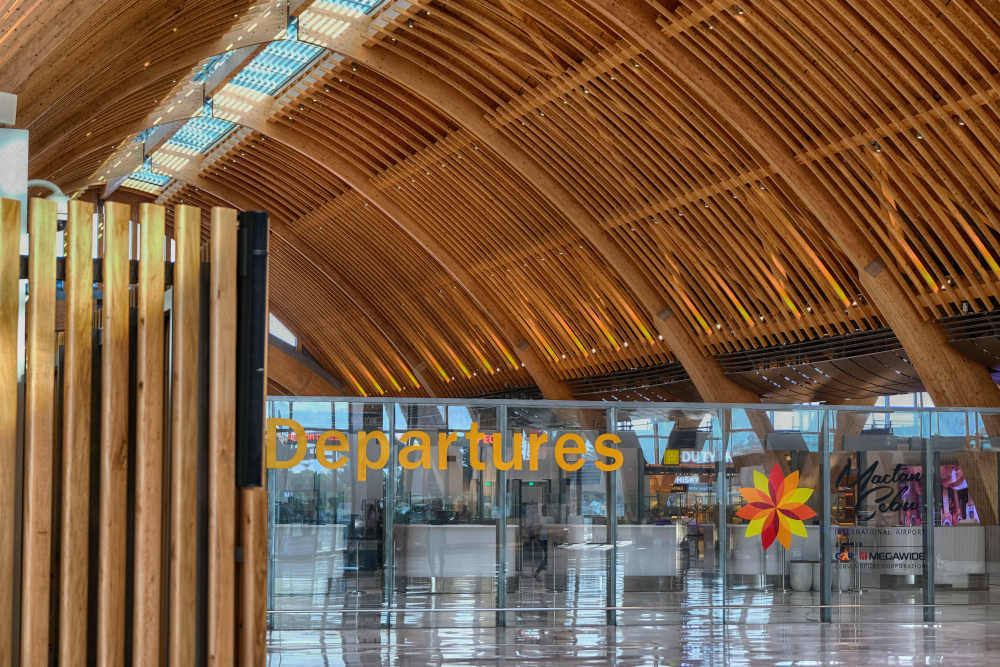
“I believe building and running commercial transport terminals is an expertise. The government should recognise this to make sure that risks are reduced, and the success level of the project is optimised and ensured,” Pineda says.
BUDJI+ROYAL and Cobonpue are co-designing the expansion and retrofitting of the original terminal. “We want to surprise the people. It will be a tropical and airy T1 (Terminal 1). Working with the same building footprint, the renovated terminal will exhibit expansive sight lines and illusions of spaces. This will feature a more tropical atmosphere that brings in daylight and new scales of high ceilings. A sophisticated resort ambiance, featuring the culture, festivals and artistry of Cebu, will be experienced all throughout,” Pineda says.
“Our vision for it is to create something more distinctly Filipino,” promises Cobonpue.
This article originally appeared in Issue No. 156 of PropertyGuru Property Report Magazine
Recommended
Meet the vagabond architect behind India’s housing scene
Vinu Daniel is helping to shake up India’s home building setting
Where Asian real estate stands in a fragmented, warmer world
Asia’s real estate industry faces many and varied challenges as external factors continue to bite
6 sights to see in Singapore’s Marine Parade
Handily located Marine Parade has emerged as a vibrant investment choice in the Lion City
There’s a township dedicated to health and wellness in Malaysia
Property seekers have their health needs catered for at KL Wellness City





